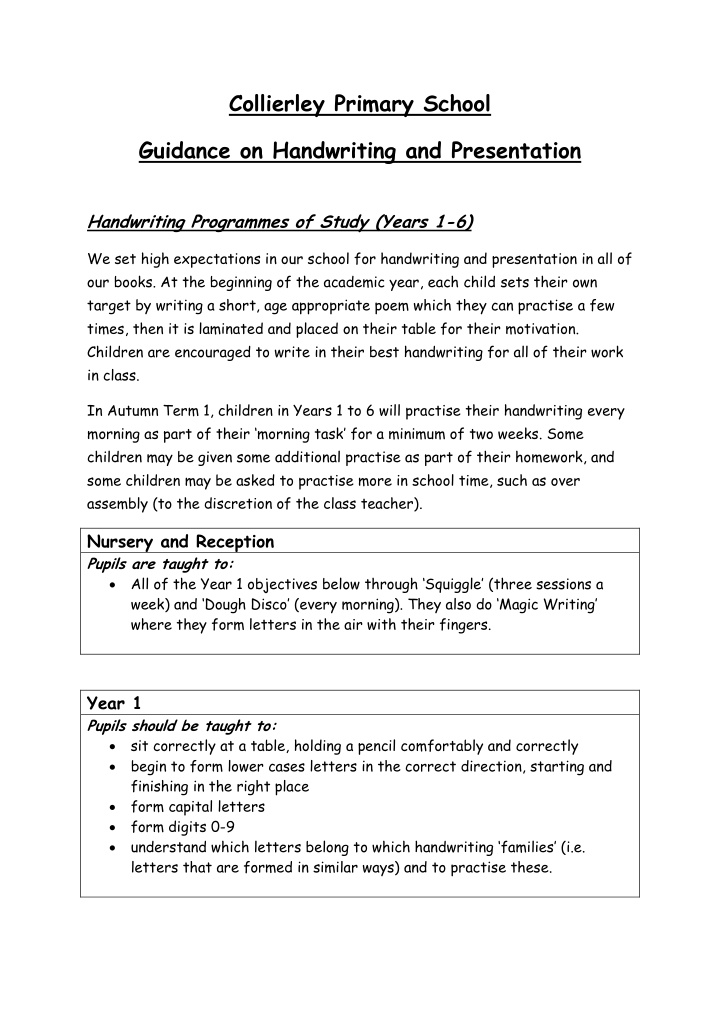



Collierley Primary School Guidance on Handwriting and Presentation Handwriting Programmes of Study (Years 1-6) We set high expectations in our school for handwriting and presentation in all of our books. At the beginning of the academic year, each child sets their own target by writing a short, age appropriate poem which they can practise a few times, then it is laminated and placed on their table for their motivation. Children are encouraged to write in their best handwriting for all of their work in class. In Autumn Term 1, children in Years 1 to 6 will practise their handwriting every morning as part of their ‘morning task’ for a minimum of two weeks. Some children may be given some additional practise as part of their homework, and some children may be asked to practise more in school time, such as over assembly (to the discretion of the class teacher). Nursery and Reception Pupils are taught to: All of the Year 1 objectives below thr ough ‘Squiggle’ (three sessions a week) and ‘Dough Disco’ (every morning). They also do ‘Magic Writing’ where they form letters in the air with their fingers. Year 1 Pupils should be taught to: sit correctly at a table, holding a pencil comfortably and correctly begin to form lower cases letters in the correct direction, starting and finishing in the right place form capital letters form digits 0-9 understand which letters belong to which handwriting ‘families’ (i.e. letters that are formed in similar ways) and to practise these.
Year 2 Pupils should be taught to : form lower-case letters of the correct size relative to one another start using some of the diagonal and horizontal strokes needed to join letters and understand which letters, when adjacent to one another, are best left unjoined write capital letters and digits of the correct size, orientation and relationship to one another and to lower-case letters use spacing between words that reflects the size of the letters Years 3-4 Pupils should be taught to : use the diagonal and horizontal strokes that are needed to join letters and understand which letters, when adjacent to one another, are best left unjoined increase the legibility, consistency and quality of their handwriting (e.g. ensuring that the down strokes of letters are parallel and equidistant; that lines of writing are spaced sufficiently so that ascenders and descenders of letters do not touch) Years 5-6 Pupils should be taught to : write legibly, fluently and with increasing speed by: choosing which shape of letter to use when given choices and deciding, as part of their personal style, whether to join or not choosing the writing implement that is best suited for the task Handwriting is monitored at the end of every half term (to begin with) as part of our writing scrutiny/ moderation sessions within key stages and as a whole school. Action will be taken to ensure that all pupils are making good progress with their handwriting. *Fine motor skills group intervention????? Presentation
All of our children are expected to take pride in their work and always try their best to produce work that is consistent and presented to the best of their ability. Every child in school is modelled good presentation skills by their teacher and teaching assistant(s) every day. Children are equipped with the necessary resources to ensure good presentation (and some older children bring their own). All staff monitors children’s work so that they consistently use good presentation in the following ways: writing the date (words in English KS2/ numerical in Maths KS2 and for both in KS1) underlining the date with a ruler (Key Stage 2) use an eraser to edit a mistake effectively in EYFS and KS) use a ruler to edit a mistake (a clear horizontal line through it or a small cross at the beginning and the end if it is a large amount) in KS2 self-assess/ self-mark their own work neatly (comments and/ or ticks) peer-assess/ peer- mark the work of others neatly (“) use the correctly-coloured pens (blue, red and green) as stated in the marking policy always finishing a sentence correctly Children’s presentation will be monitored every half term (to begin with) as part of our writing scrutiny/ moderation sessions within key stages and as a whole school. Action will be taken to ensure that all pupils are making good progress with their handwriting. This could be with additional skills practise for that child in school or as part of their homework. Some of our older children are great ‘buddies’ and share their skills with our younger children during short intervention activities during some assemblies and break times.
Recommend
More recommend